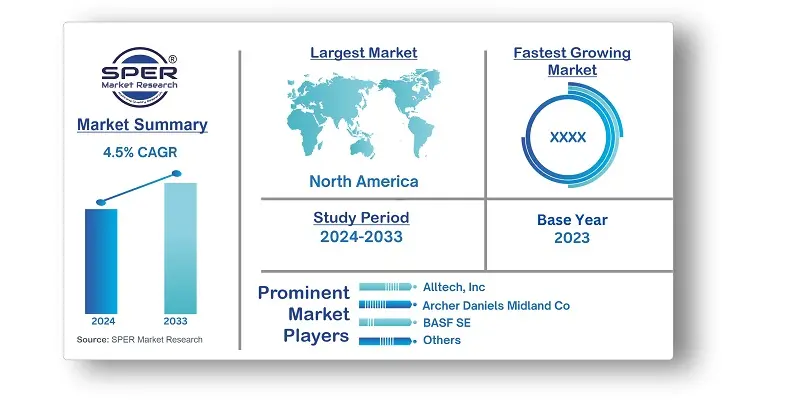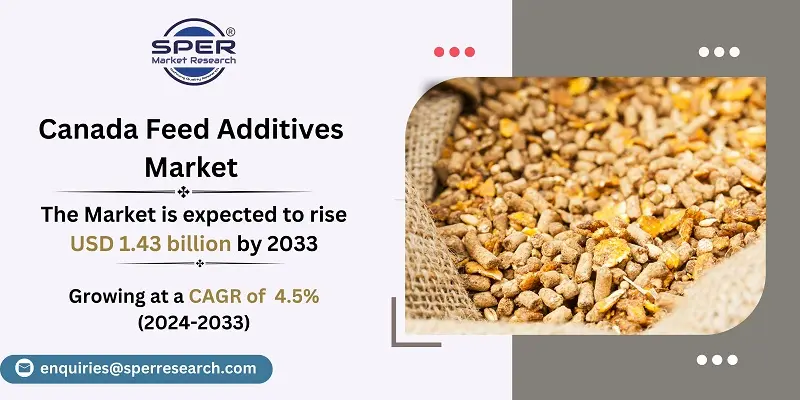
Canada Feed Additives Market Growth, Size, Trends, Share, Revenue, Demand and Future Outlook
Canada Feed Additives Market Size- By Type, By Form, By Livestock, By Source- Regional Outlook, Competitive Strategies and Segment Forecast to 2033
| Published: Mar-2024 | Report ID: AGRI2408 | Pages: 1 - 106 | Formats*: |
| Category : Agriculture | |||
- October 2022: Through their collaboration with BASF, Evonik was granted non-exclusive licencing rights to OpteinicsTM, a digital solution that enhances comprehension and lessens the environmental effect of the feed and animal protein industries.
- In June 2022: Delacon and Cargill joined together to launch a global company focused on plant-based phytogenic feed additives for improved animal nutrition. The collaboration has aided in expanding worldwide footprint and providing in-depth knowledge of feed additives.
- April 2022: Elanco and Royal DSM have formed a strategic alliance for Bovaer, a cutting-edge cattle feed ingredient that lowers methane emissions.


| Report Metric | Details |
| Market size available for years | 2020-2033 |
| Base year considered | 2023 |
| Forecast period | 2024-2033 |
| Segments covered | By Type, By Form, By Livestock, By Source |
| Regions covered | Alberta, Atlantic Canada, British Columbia, Central Canada, Northern Canada, The Prairies, Others |
| Companies Covered | Alltech, Inc., Archer Daniels Midland Co., BASF SE, Cargill Inc., DSM Nutritional Products AG, Elanco Animal Health Inc., Evonik Industries AG, IFF (Danisco Animal Nutrition), SHV (Nutreco NV), Solvay S.A., Others |
- Animal Nutritionists and Researchers
- Aquaculture and Fish Farming Industry
- Feed Additive Manufacturers and Suppliers
- Feed Ingredient Suppliers
- Feed Millers and Manufacturers
- Investors and Financial Institutions
- Livestock and Poultry Farmers
- Pet Food Manufacturers
- Regulatory Authorities and Government Agencies
- Veterinary Professionals
- Others
| By Type: |
|
| By Form: |
|
| By Livestock: |
|
| By Source: |
|
- Canada Feed Additives Market Size (FY’2024-FY’2033)
- Overview of Canada Feed Additives Market
- Segmentation of Canada Feed Additives Market By Type (Acidifiers, Amino Acids, Antibiotics, Enzymes, Flavours and Sweeteners, Minerals, Probiotics, Vitamins, Others)
- Segmentation of Canada Feed Additives Market By Form (Dry, Liquid)
- Segmentation of Canada Feed Additives Market By Livestock (Aquatic Animals, Poultry, Ruminants, Swine, Others)
- Segmentation of Canada Feed Additives Market By Source (Natural, Synthetic)
- Statistical Snap of Canada Feed Additives Market
- Expansion Analysis of Canada Feed Additives Market
- Problems and Obstacles in Canada Feed Additives Market
- Competitive Landscape in the Canada Feed Additives Market
- Impact of COVID-19 and Demonetization on Canada Feed Additives Market
- Details on Current Investment in Canada Feed Additives Market
- Competitive Analysis of Canada Feed Additives Market
- Prominent Players in the Canada Feed Additives Market
- SWOT Analysis of Canada Feed Additives Market
- Canada Feed Additives Market Future Outlook and Projections (FY’2024-FY’2033)
- Recommendations from Analyst
1.1. Scope of the report1.2. Market segment analysis
2.1. Research data source2.1.1. Secondary Data2.1.2. Primary Data2.1.3. SPER’s internal database2.1.4. Premium insight from KOL’s2.2. Market size estimation2.2.1. Top-down and Bottom-up approach
2.3. Data triangulation
4.1. Driver, Restraint, Opportunity and Challenges analysis4.1.1. Drivers4.1.2. Restraints4.1.3. Opportunities4.1.4. Challenges4.2. COVID-19 Impacts of the Canada Feed Additives Market
5.1. SWOT Analysis5.1.1. Strengths5.1.2. Weaknesses5.1.3. Opportunities5.1.4. Threats5.2. PESTEL Analysis5.2.1. Political Landscape5.2.2. Economic Landscape5.2.3. Social Landscape5.2.4. Technological Landscape5.2.5. Environmental Landscape5.2.6. Legal Landscape5.3. PORTER’s Five Forces5.3.1. Bargaining power of suppliers5.3.2. Bargaining power of buyers5.3.3. Threat of Substitute5.3.4. Threat of new entrant5.3.5. Competitive rivalry5.4. Heat Map Analysis
6.1. Canada Feed Additives Market Manufacturing Base Distribution, Sales Area, Product Type6.2. Mergers & Acquisitions, Partnerships, Product Launch, and Collaboration in Canada Feed Additives Market
7.1. Canada Feed Additives Market Value Share and Forecast, By Type, 2024-20337.2. Acidifiers7.3. Amino Acids7.4. Antibiotics7.5. Enzymes7.6. Flavours and Sweeteners7.7. Minerals7.8. Probiotics7.9. Vitamins7.10. Others
8.1. Canada Feed Additives Market Value Share and Forecast, By Form, 2024-20338.2. Dry8.3. Liquid
9.1. Canada Feed Additives Market Value Share and Forecast, By Livestock, 2024-20339.2. Aquatic Animals9.3. Poultry9.4. Ruminants9.5. Swine9.6. Others
10.1. Canada Feed Additives Market Value Share and Forecast, By Source, 2024-203310.2. Natural10.3. Synthetic
11.1. Canada Feed Additives Market Size and Market Share
12.1. Canada Feed Additives Market Size and Market Share By Type (2020-2027)12.2. Canada Feed Additives Market Size and Market Share By Type (2028-2033)
13.1. Canada Feed Additives Market Size and Market Share By Form (2020-2027)13.2. Canada Feed Additives Market Size and Market Share By Form (2028-2033)
14.1. Canada Feed Additives Market Size and Market Share By Livestock (2020-2027)14.2. Canada Feed Additives Market Size and Market Share By Livestock (2028-2033)
15.1. Canada Feed Additives Market Size and Market Share By Source (2020-2027)15.2. Canada Feed Additives Market Size and Market Share By Source (2028-2033)
16.1. Canada Feed Additives Market Size and Market Share By Region (2020-2027)16.2. Canada Feed Additives Market Size and Market Share By Region (2028-2033)16.3. Alberta16.4. Atlantic Canada16.5. British Columbia16.6. Central Canada16.7. Northern Canada16.8. The Prairies16.9. Others
17.1. Alltech, Inc.17.1.1. Company details17.1.2. Financial outlook17.1.3. Product summary17.1.4. Recent developments17.2. Archer Daniels Midland Co.17.2.1. Company details17.2.2. Financial outlook17.2.3. Product summary17.2.4. Recent developments17.3. BASF SE17.3.1. Company details17.3.2. Financial outlook17.3.3. Product summary17.3.4. Recent developments17.4. Cargill Inc.17.4.1. Company details17.4.2. Financial outlook17.4.3. Product summary17.4.4. Recent developments17.5. DSM Nutritional Products AG17.5.1. Company details17.5.2. Financial outlook17.5.3. Product summary17.5.4. Recent developments17.6. Elanco Animal Health Inc.17.6.1. Company details17.6.2. Financial outlook17.6.3. Product summary17.6.4. Recent developments17.7. Evonik Industries AG17.7.1. Company details17.7.2. Financial outlook17.7.3. Product summary17.7.4. Recent developments17.8. IFF (Danisco Animal Nutrition)17.8.1. Company details17.8.2. Financial outlook17.8.3. Product summary17.8.4. Recent developments17.9. SHV (Nutreco NV)17.9.1. Company details17.9.2. Financial outlook17.9.3. Product summary17.9.4. Recent developments17.10. Solvay S.A.17.10.1. Company details17.10.2. Financial outlook17.10.3. Product summary17.10.4. Recent developments17.11. Others
SPER Market Research’s methodology uses great emphasis on primary research to ensure that the market intelligence insights are up to date, reliable and accurate. Primary interviews are done with players involved in each phase of a supply chain to analyze the market forecasting. The secondary research method is used to help you fully understand how the future markets and the spending patterns look likes.
The report is based on in-depth qualitative and quantitative analysis of the Product Market. The quantitative analysis involves the application of various projection and sampling techniques. The qualitative analysis involves primary interviews, surveys, and vendor briefings. The data gathered as a result of these processes are validated through experts opinion. Our research methodology entails an ideal mixture of primary and secondary initiatives.



Frequently Asked Questions About This Report
PLACE AN ORDER
Year End Discount
Sample Report
Pre-Purchase Inquiry
NEED CUSTOMIZATION?
Request CustomizationCALL OR EMAIL US
100% Secure Payment






Related Reports
Our Global Clients
Our data-driven insights have influenced the strategy of 200+ reputed companies across the globe.






















